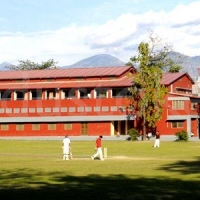Welham Boys School in Dehradun, Uttarakhand Admission, Fees Structure

Where is Welham Boys School ?
Welham Boys School is Located in Dehradun , Uttarakhand, India
Address of Welham Boys School, Dehradun
5, Circular Road, Dalanwala,
Dehradun - 248001,
Uttarakhand, India
+91-135-2657120, 2652935
welham1937@welhamboys.org
How do I contact Welham Boys School?
Call at +91-135-2657120 to contact Welham Boys School
About Welham Boys School
Founded as the Welham Preparatory School in 1937, by way of a small self investment,
Ms Oliphant established an institution that in time would establish itself as one of the finest high schools in the country.
An early concern was finance and this was taken care of by a grant from Ms Oliphant's mother who sent the money from the village of Welham, England, in which Ms Oliphant spent her childhood.
Ms Oliphant came to India in 1920 and moved to Dehradun, from Delhi. She resolved to start a preparatory school in this salubrious and idyllic town, nestled in the Himalayan foothills. The first boy joined on 15 January, 1937 and within a year, there were thirty residential and twenty day scholars. Grade 5 was added in 1941 and by 1945, admissions swelled and the institution stood on solid footing. In 1941, the school banner was carried for the first time ever in the Games March Past, and on it was the school motto: 'From Strength to Strength'.
In time, Welham was recognised as a Preparatory School of repute, with a burgeoning student body as well as real estate. It's students acquired a sound foundation in English while talents as varied as art, carpentry and sports were honed individually.
Ms Oliphant donated all her assets to the Welham Boys' School Society in 1956 which today is administered by a Board of Trustees. It is to her vision and effort, and that of Principals who succeeded her, that Welham is a pioneer institute of learning today. Elevated to plus two Secondary School in 1985, Welham today is affiliated to the CBSE curriculum and prides itself in being among the foremost private schools in the country.
The city is noted for its picturesque landscape and slightly milder climate and provides a gateway to the surrounding region It is well connected and in proximity to Himalayan tourist destinations such as Mussoorie, Dhanaulti, Chakrata, New_Tehri, Uttarkashi, Harsil, Chopta - Tungnath, Auli, India, famous summer and winter trekking destinations like Dodital, Dayara Bugyal, Kedarkantha, Har Ki Dun for camping and grandeur Himalayan panoromic views The Hindu holy cities of Haridwar and Rishikesh along with the Himalayan pilgrimage circuit of Chota Char Dham ie Yamunotri, Gangotri, Kedarnath and Badrinath.
Dehradun is also known for its Basmati rice and bakery products Dehradun is a notable academic and research hub and is home to Indian Military Academy, Rashtriya Indian Military College, Uttarakhand Ayurveda University, Forest Research Institute, Wadia Institute of Himalayan Geology, and Indira Gandhi National Forest Academy According to the combined survey based on health, infrastructure, economy, education and safety; conducted by Dainik Jagran and KPMG, Dehradun is one of the safest cities to live in The city stands at an elevation of approximately 700 metres (2,300 ft) above sea level Also known as the ‘Abode of Drona’, Dehradun has been an important centre for Garhwal rulers which was captured by the British.
Often referred as the gateway to Mussorie Uttarakhand Police is the main law enforcement agency in the city
The winter capital of Uttarakhand is Dehradun, the largest city of the state, which is a rail head Gairsain, a town in Chamoli district is the summer capital of Uttarakhand The High Court of the state is located in Nainital Archaeological evidence supports the existence of humans in the region since prehistoric times The region formed a part of the Uttarakuru Kingdom during the Vedic age of Ancient India.
Among the first major dynasties of Kumaon were the Kunindas in the 2nd century BCE who practised an early form of Shaivism Ashokan edicts at Kalsi show the early presence of Buddhism in this region During the medieval period, the region was consolidated under the Katyuri rulers of Kumaon also known as 'Kurmanchal Kingdom' After the fall of Katyuris, the region was divided into the Kumaon Kingdom and the Garhwal Kingdom In 1816, most of modern Uttarakhand was ceded to the British as part of the Treaty of Sugauli.
Although the erstwhile hill kingdoms of Garhwal and Kumaon were traditional rivals, the proximity of different neighbouring ethnic groups and the inseparable and complementary nature of their geography, economy, culture, language, and traditions created strong bonds between the two regions, which further strengthened during the Uttarakhand movement for statehood in the 1990s The natives of the state are generally called Uttarakhandi, or more specifically either Garhwali or Kumaoni by their region of origin According to the 2011 Census of India, Uttarakhand has a population of 10,086,292, making it the 20th most populous state in India